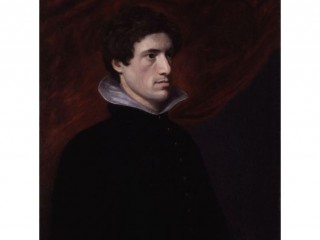
Charles Lamb biography
Date of birth : 1775-02-10
Date of death : 1834-12-27
Birthplace : London, England
Nationality : British
Category : Famous Figures
Last modified : 2011-02-03
Credited as : Author and critic, minor poet, Essays of Elia
The English author, critic and minor poet Charles Lamb is best known for the essays he wrote under the name Elia. He remains one of the most loved and read of English essayists.
Charles Lamb was born on Feb. 10, 1775, in London. At the age of 7 he entered Christ's Hospital, a free boarding school for sons of poor but genteel parents. After beginning a lifelong friendship with Samuel Taylor Coleridge, a fellow student, Lamb left school in 1789. In 1792 he was hired as a clerk in the East India Company and worked there for the next 33 years.
On Sept. 22, 1796, Lamb's sister, Mary, in a moment of anxious rage, stabbed their mother to death. An inquest found Mary temporarily insane and placed her in the custody of Charles. After the death of their father in 1799, Mary came to live with Charles for the rest of his life. This companionship was broken only at intervals when the symptoms of Mary's illness recurred so that she had to enter an asylum. This lifelong guardianship prevented Lamb from ever marrying. He himself had spent 6 weeks in an asylum during the winter of 1795, stuttered badly all his life, and became increasingly dependent on alcohol. It is quite possible that his responsibility to Mary helped him to keep a firmer grip on his own sanity.
Lamb's literary career began in 1796, when Coleridge published four of Lamb's sonnets in his own first volume, Poems on Various Subjects. In 1798 Lamb published his sentimental romance, A Tale of Rosamund Gray, and, together with Charles Lloyd, a friend of Coleridge, brought out a volume entitled Blank Verse. By 1801 Lamb had begun to contribute short articles to London newspapers and to write plays in an effort to relieve the poverty he and Mary endured. In 1802 he published John Woodvil, a blank-verse play which enjoyed no success, and on the night of Dec. 10, 1806, his two-act farce, Mr. H., was greeted by "a hundred hisses" at the Drury Lane Theatre.
In 1807 Charles and Mary together brought out Tales from Shakespeare, a collection of prose adaptations of Shakespeare's plays intended for young readers. The book proved popular with both young and old, and the Lambs followed up this success with others in the same vein. In 1808 Charles published his own version of Homer's Odyssey for children, The Adventures of Ulysses, and in 1809 he collaborated again with Mary on Mrs. Leicester's School, a book of children's stories, and Poetry for Children.
Meanwhile Lamb began a new aspect of his career in 1808 by editing the anthology Specimens of the English Dramatic Poets Who Lived about the Time of Shakespeare. Lamb's brilliant comments on the selections he chose began his reputation as a critic, and the entire volume was largely responsible for the revival of interest in Shakespeare's contemporaries which followed its publication. Lamb furthered his critical career with essays "On the Genius and Character of Hogarth" and "The Tragedies of Shakespeare," published in Leigh Hunt's journal, the Reflector, in 1811. In 1818 he brought out a two-volume collection The Works of Charles Lamb. Ironically, his real literary career was yet to begin.
Though Lamb was still far from famous, these years were among the happiest of his life. At their home in Inner Temple Lane, he and Mary entertained their friends at a number of late Wednesday evening gatherings. The company included many of the famous authors of the romantic period—Coleridge, William Wordsworth, Robert Southey, William Hazlitt, and Hunt. Yet according to Hazlitt, Lamb "always made the best pun and the best remark" of the evening. Also, Lamb's letters to these friends during these years are among the best things he ever wrote. Filled with excellent critical comments, they also reveal much of the wistful humor of Lamb's own personality.
These letters no doubt did much to prepare Lamb for his forthcoming triumph as a familiar essayist. From 1820 through 1825 he contributed a series of essays to the London Magazine which were immensely popular. Though he wrote under the pseudonym Elia, these essays, like his letters, are intimate revelations of Lamb's own thoughts, emotions, and experiences of literature and life. He touches on few disturbing subjects. He prefers instead to look to the past for a sense of calm, stability, and changelessness. Yet beneath the wit, humor, and humanity of such essays as "A Dissertation upon Roast Pig," "Witches and Other Night-Fears," and "Dream Children," one finds a gentle nostalgia and melancholy. This bittersweet tone remains the hallmark of Lamb's style.
In 1823 Charles and Mary met and eventually adopted an orphan girl, Emma Isola. In August the Lambs moved from London for the first time, to Islington and then to Enfield. Charles's health was weakening, and a long illness during the winter of 1824 led him to retire permanently from the East India Company. He now occupied his time with walking trips around Hertfordshire with Emma Isola.
By 1833 the frequency and duration of Mary's attacks had increased so that she needed almost constant care, so the Lambs moved to Edmonton to be near Mary's nurse. Charles ended his literary career the same year with Last Essays of Elia. In July, Emma's marriage to Charles's friend Edward Moxon left him depressed and lonely. One year later the death of Coleridge made that loneliness acute. "I feel how great a part he was of me," wrote Lamb. Five weeks later, on Dec. 27, 1834, Lamb himself was dead.
















